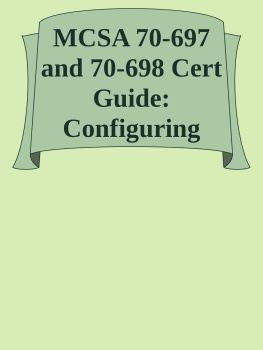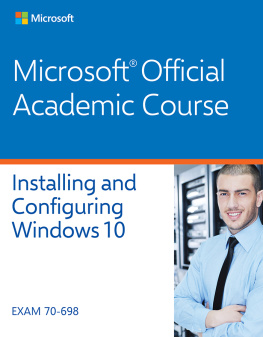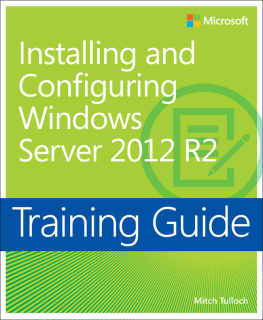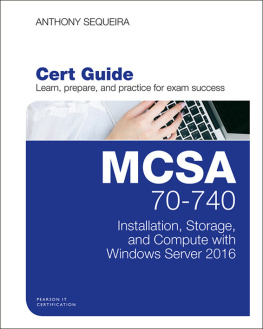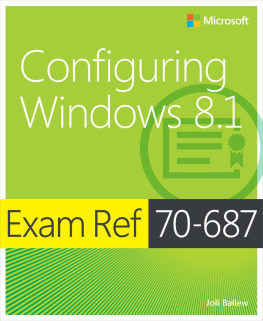Microsoft - MCSA 70-697 and 70-698 Cert Guide: Configuring Windows Devices
Here you can read online Microsoft - MCSA 70-697 and 70-698 Cert Guide: Configuring Windows Devices full text of the book (entire story) in english for free. Download pdf and epub, get meaning, cover and reviews about this ebook. year: 2016, genre: Computer. Description of the work, (preface) as well as reviews are available. Best literature library LitArk.com created for fans of good reading and offers a wide selection of genres:
Romance novel
Science fiction
Adventure
Detective
Science
History
Home and family
Prose
Art
Politics
Computer
Non-fiction
Religion
Business
Children
Humor
Choose a favorite category and find really read worthwhile books. Enjoy immersion in the world of imagination, feel the emotions of the characters or learn something new for yourself, make an fascinating discovery.
MCSA 70-697 and 70-698 Cert Guide: Configuring Windows Devices: summary, description and annotation
We offer to read an annotation, description, summary or preface (depends on what the author of the book "MCSA 70-697 and 70-698 Cert Guide: Configuring Windows Devices" wrote himself). If you haven't found the necessary information about the book — write in the comments, we will try to find it.
Microsoft: author's other books
Who wrote MCSA 70-697 and 70-698 Cert Guide: Configuring Windows Devices? Find out the surname, the name of the author of the book and a list of all author's works by series.
MCSA 70-697 and 70-698 Cert Guide: Configuring Windows Devices — read online for free the complete book (whole text) full work
Below is the text of the book, divided by pages. System saving the place of the last page read, allows you to conveniently read the book "MCSA 70-697 and 70-698 Cert Guide: Configuring Windows Devices" online for free, without having to search again every time where you left off. Put a bookmark, and you can go to the page where you finished reading at any time.
Font size:
Interval:
Bookmark:
In recent years, more and more individuals have been attracted to mobile devices such as smartphones and tablets marketed by manufacturers such as Apple, Samsung, and Android, equipped with touchscreens that have become increasingly simple to use and navigate. Accompanying these devices is an increasing number of simple applications (known simply as apps) that enable the user to perform such tasks as locating restaurants while in a strange city, or knowing when her kids arrive home from school. At the same time, computer manufacturers have come out with laptops and mobile devices equipped with touch-sensitive displays; additionally, touch-sensitive monitors have become available for the still ubiquitous desktop computer.
Windows 7 brought with it significant enhancements in the usability and security of Microsoft's flagship operating system. Included was an array of touch-sensitive options, but these lagged considerably behind those being offered by competitors in the mobile device business. Windows 8 brought a new Start screen-based desktop environment that was not accepted by the majority of Windows users, prompting Microsoft to bring back many of the discarded features into the Windows 8.1 update. Windows 10 improves the desktop experience even further by combining the familiar feel of older Windows desktops with the ease of locating and running apps from its redesigned Start menu, accompanied with the same right-click Start menu (also known as the Quick Access Menu) from Windows 8.1, which facilitates the execution of most of the tools that desktop support staff and administrators rely upon in the performance of their daily tasks.
Microsoft has stated that Windows 10 will be the last version of Windows. That doesnt mean that it will not be updating the operating system, it means that Windows 10 becomes the first of the new Windows as a service delivery model for the OS. Instead of a major update every few years, Microsoft will push out minor and major updates to Windows on a frequent basis. They may decide to brand it Windows 11 or Windows 12 in the future, but it will be delivered the same way that regular OS updates are delivered: via Windows Update.
There are now just two release types for Windows, eliminating the major version releases such as Windows 8.1, Windows 8, and so on. Instead, there will only be feature updates, delivering new functionality two to three times per year, and quality updates that provide security and reliability fixes at least once per month. So instead of purchasing an upgrade or new computer every 3 to 5 years, feature updates will come from Microsoft much more frequentlytwo to three times per yearin bite-sized chunks, making it easier for users to become familiar with new features.
As with past Windows versions, Microsoft continues to release frequent updates to its operating systems, still relying on the popular series of "Patch Tuesday" updates, but delivered as monthly cumulative updates instead of individual patches. Many of these are directed at fixing bugs and intrusions as cracks and vulnerabilities surface. Further, hardware manufacturers provide driver updates from time to time; so do third-party software providers. This chapter also introduces you to the Windows Update feature that enables users to download and install all available updates from the Windows Update website. For the 70-697 exam, Microsoft expects you to know how to use Windows Update to provide the proper updates to drivers, software programs, and operating system files.
The Do I Know This Already? quiz allows you to assess whether you should read this entire chapter or simply jump to the Exam Preparation Tasks section for review. If you are in doubt, read the entire chapter. outlines the major headings in this chapter and the corresponding Do I Know This Already? quiz questions. You can find the answers in Appendix A, Answers to the Do I Know This Already? Quizzes.
Table 1-1. Do I Know This Already? Foundation Topics Section-to-Question Mapping
Foundations Topics Section | Questions Covered in This Section |
A Brief History of Windows | |
Features Tour of Windows 10 | |
A Quick Tour of Windows 10 | |
Configuring Windows Updates | |
Configuring Updates | 1112 |
Caution
The goal of self-assessment is to gauge your mastery of the topics in this chapter. If you do not know the answer to a question or are only partially sure of the answer, you should mark that question as wrong for purposes of the self-assessment. Giving yourself credit for an answer you correctly guess skews your self-assessment results and might provide you with a false sense of security.
In what way is Windows 10 Education different from Windows 10 Enterprise?
a. Windows 10 Education does not provide for joining an Active Directory Domain Services (ADDS) domain.
b. Windows 10 Education does not include advanced security features, such as BitLocker, Credential Guard, Trusted Boot, or Encrypting File System.
c. Windows 10 Education does not include the ability to use Remote Desktop or Remote Assistance.
d. Windows 10 Education includes all features of Windows 10 Enterprise and differs only in that it is available with Microsofts Academic Volume Licensing for schools, universities, and colleges.
Which of the following actions requires that you install Windows 10 Pro, Windows 10 Education, or Windows 10 Enterprise, in contrast to Windows 10 Home? (Choose all that apply.)
a. Joining a Windows Server domain
b. Using Windows Firewall to safeguard your computer
c. Using more than one monitor on your computer
d. Encrypting files using Encrypting File System (EFS)
Which of the following is not visible when you click Start on a Windows 10 computer?
a. The desktop, together with shortcut icons
b. A menu containing administrative utilities
c. Tiles for Windows apps
d. An alphabetical list of installed programs and apps
Which of the following tasks can you perform from the Windows Settings screen in Windows 10? (Choose all that apply.)
a. Select lock screen, start screen, and wallpaper images
b. Create new user accounts
c. Specify time zone and language options
d. Install hardware devices
e. Configure accessibility options
f. Create a new HomeGroup or join an existing HomeGroup
Which of the following categories of the Control Panel applet includes tools for managing File History and Backup and Restore?
a. Network and Internet
b. Programs
c. System and Security
d. Appearance and Personalization
e. User Accounts
Microsoft has packaged a set of updates that is designed to fix problems with specific Windows components or software packages such as Microsoft Office. What is this package known as?
a. A critical security update
b. An optional update
c. An update roll-up
d. A service pack
Your Windows 10 Pro computer is shared among several users in your small office. Occasionally, others have informed you that the computer slows down and displays a message informing them to restart the computer to complete installing updates. This frequently occurs when they are performing important tasks that they do not want to interrupt. What should you do to ensure that all updates are installed but not until after business hours? Each correct answer represents a complete solution. Choose two answers.
Font size:
Interval:
Bookmark:
Similar books «MCSA 70-697 and 70-698 Cert Guide: Configuring Windows Devices»
Look at similar books to MCSA 70-697 and 70-698 Cert Guide: Configuring Windows Devices. We have selected literature similar in name and meaning in the hope of providing readers with more options to find new, interesting, not yet read works.
Discussion, reviews of the book MCSA 70-697 and 70-698 Cert Guide: Configuring Windows Devices and just readers' own opinions. Leave your comments, write what you think about the work, its meaning or the main characters. Specify what exactly you liked and what you didn't like, and why you think so.

